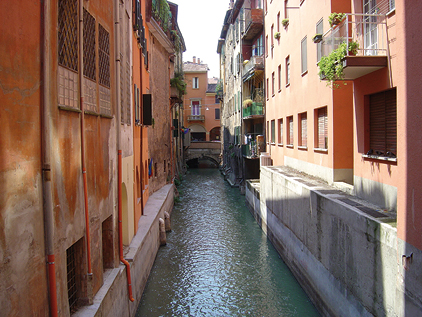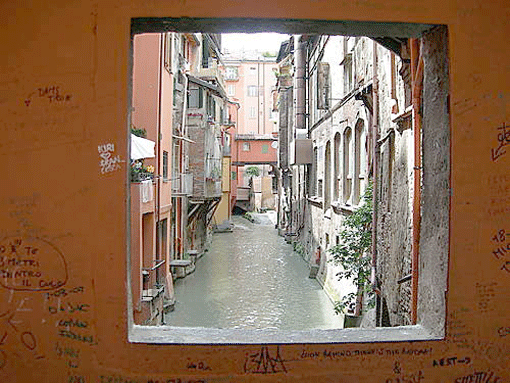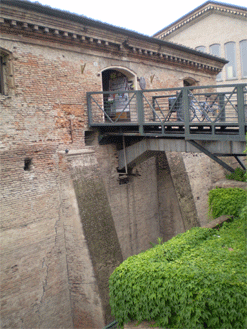Ponte della CaritÓ, Ponte della Badýa, Ponte della Sega,
Ponte del Fondego, Ponte dei Preti: in Bologna, there were more or less
fifty bridges. This means that it was necessary to step over streams of
water. Of course. Because Felsina (then Bonomia, then Bologna) was founded
and grew near the Aposa Creek to be able to take advantage of the
necessary water resources for the community. It is formed by the two main
waterways of the area, the Reno River and the Savena River. Two dams were
built around year 1000 and two canals from which other canals were
branched, on the surface, other canals, small ones, outflows and,
underground, a dense network of conduits and tunnels.
The whole
economy and development of the city, since the Middle Ages, is founded on
that abundant natural wealth: water, which fed, as the driving force, the
growing manufacturing crafts: paper factories, "purghi", mills,
millstones, fulling mills, sawmills, tanneries, hammer mills, spinning
mills; there were also retteries, orchards, fish ponds that received the
essential water supply.
Since the mid-eleventh century, the City
realized within the urban walls the Reno Canal, going through the last
circle of walls crossing the Grada, the last leg, at the exit of the City,
called the Moline Canal. They also develop the Cavaticcio, in the ancient
Aposa Canal, and the Navile Canal bringing together the old canal which
from Corticella led to the Po.
And then was born the Maccagnano port,
outside of the walls, in the Bova community (today Via Bovi Campeggi).
Later, Giovanni II Bentivoglio wanted to transfer it within the city walls
and inaugurated the new complex on January 10th, 1494. Still later, at the
end of the sixteenth century, Antonio Baruzzi, called Vignola, redesigned
and rebuilt it with customs, warehouses, taverns, inns, wet docks,
shipyard, wharfs, small staircases in masonry to access the ships, for
which were organized at least 50 places. Thus, cargo (salt from the
salt mines of Cervia, wheat, rice, corn, hemp, cotton, silk, fish, timber,
leather) and passengers from the port, by the Navile Canal, could reach
the Po, Ferrara, Venice, on barges often towed by horses along the
towpaths.
Within the walls, in the leg of the Savena Canal along Via
Castiglione, described Robert Scannavini, architect, there were the wool
factories; along the Rialto and Castellata streets there were tanners,
dyers, rope makers, stationers and hydraulic spinning mills; wheat-mills,
rice-mills were in the initial agreement for the Reno Canal; between the
Lame and the Galliera streets, hydraulic silk-mills and rice-mills;
milling and tanneries were in the final agreement, called "the Moline".


For centuries (until the 700), the water has moved hundreds of manufacturing activities that were carried out basements and ground floors of houses which, in the back, overlooked the canals and with shops on the porticoed street. Source of energy and means of communication, water, therefore, has characterized, since the twelfth century, the urban environment and supported the economy of Bologna. Little by little was covered and hidden what was the hydraulic "treasure" of the city. Today it is reappearing, discreet and irregular, enough though to give an idea of the atmosphere and customs now gone: through the small windows on Via Piella (where we can see the silent flow of the water and houses as though it was behind the scenes, lost in time), in recent decades there has been restoration work done on the fašades of the Reno Canal in Via Piella and in Via Malcontenti;
of the Gallotti brickyard, the Salara, the old
harbour area; the revitalization of the former mill Grada, the improvement
of the underground canalization of the Aposa with the rediscovery of the
Roman bridge.
And there is a jewel in the "water history" of
Bologna: the renovated octagonal reservoir in Via Bagni di Mario, outside
of the gate of S. Mamolo, designed by Tommaso Laureti and built in 1564,
to collect the water intended to supply the contemporary statue of
Neptune.
To visit it is a journey in the history of the city and
more.